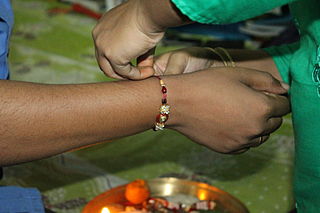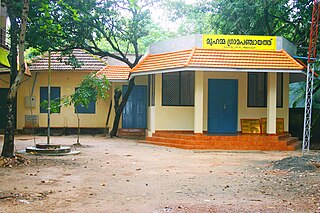
India is the second most populated country in the world with nearly a fifth of the world's population. According to the 2019 revision of the World Population Prospects the population stood at 1,352,642,280.

Maharashtra is a state in the western and central peninsular region of India occupying a substantial portion of the Deccan Plateau. The centre of India is in this state. Maharashtra is the second-most populous state in India as well as the third-most populous country subdivision in the world. It was formed on 1 May 1960 by splitting the bilingual Bombay State, which had existed since 1956, into majority Marathi-speaking Maharashtra and Gujarati-speaking Gujarat. Thus Maharashtra is a Marathi linguistic state. The state is divided into 6 divisions and 36 districts, with the state capital being Mumbai, also the most populous urban area in India and Nagpur serving as the winter capital. The Godavari and the Krishna are the two major rivers in the state. Marathi is the most widely spoken language and is also the official language of the state. The forest cover in the state is 16.47% of the state's geographical area. Out of total cultivable land in Maharashtra about 60% land is under food grain crops with Jowar being the dominating crop.

Rajasthan is a state located in northern India. The state covers an area of 342,239 square kilometres (132,139 sq mi) or 10.4 percent of the total geographical area of India. It is the largest Indian state by area and the seventh largest by population. Rajasthan is located on the northwestern side of India, where it comprises most of the wide and inhospitable Thar Desert and shares a border with the Pakistani provinces of Punjab to the northwest and Sindh to the west, along the Sutlej-Indus river valley. It is bordered by five other Indian states: Punjab to the north; Haryana and Uttar Pradesh to the northeast; Madhya Pradesh to the southeast; and Gujarat to the southwest. Its geographical location is 23.3 to 30.12 North latitude and 69.30 to 78.17 East longitude, with the Tropic of Cancer passing through the southernmost tip of the state.

Meghalaya is a state in Northeast India. Meghalaya was formed by carving out two districts from the state of Assam: the United Khasi Hills and Jaintia Hills, and the Garo Hills on 21 January 1972. Meghalaya was previously part of Assam, but on 21 January 1972, the districts of Khasi, Garo and Jaintia hills became the new state of Meghalaya. The population of Meghalaya as of 2016 is estimated to be 3,211,474. Meghalaya covers an area of approximately 22,430 square kilometres, with a length-to-breadth ratio of about 3:1.

Mizoram is a state in northeastern India, with Aizawl as its seat of government and capital city. The name of the state is derived from "Mizo", the self described name of the native inhabitants, and "Ram", which in the Mizo language means "land." Thus "Mizo-ram" means "land of the Mizos". Within India's northeast old-Assam region, it is the southernmost landlocked state, sharing borders with three of the Seven Sister States of old Assam, namely Tripura, Assam and Manipur. The state also shares a 722-kilometre (449 mi) border with the neighbouring countries of Bangladesh and Myanmar.

Raksha Bandhan, also Rakshabandhan, is a popular, traditionally Hindu, annual rite, or ceremony, which is central to a festival of the same name, celebrated in South Asia, and among people around the world influenced by Hindu culture. On this day, sisters of all ages tie a talisman, or amulet, called the rakhi, around the wrists of their brothers, symbolically protecting them, receiving a gift in return, and traditionally investing the brothers with a share of the responsibility of their potential care.
Gram Panchayat is a basic village-governing institute in Indian villages. It is a democratic structure at the grass-roots level in India. It is a political institute, acting as cabinet of the village. The Gram Sabha work as the general body of the Gram Panchayat. The members of the Gram Panchayat are elected by the Gram Sabha.
The administrative divisions of India are subnational administrative units of India; they are composed of a nested hierarchy of country subdivisions.
A sarpanch or gram pradhan or mukya is a decision-maker, elected by the village-level constitutional body of local self-government called the Gram Sabha in India. The sarpanch, together with other elected panchayat members, constitute gram panchayats and zilla panchayats. The sarpanch is the focal point of contact between government officers and the village community and retains power for five years.

Panchayati Raj is the system of local self-government of villages in rural India as opposed to urban and suburban municipalities.

Sansarpur is a village in Jalandhar district in the Indian state of Punjab.
Ramapur village and post, or Rama Pur as it is known for postal purposes, is a village-gram panchayat in Pawai Block, Phulpur, Azamgarh, Uttar Pradesh, India. The inhabitants of the village follow Lord Rama and Sita in whose honor this village name was kept Ramapur in ancient days. This village has an internal relationship with Bishunpur, Jaunpur in a well defined religious and social perspective.

RannaBelagali is a Pattan Panchayat Town in the southern state of Karnataka, India. It is located in the Mudhol taluka of Bagalkot district in Karnataka

Hulagabali is a village in the southern state of Karnataka, India. It is located in the Athani taluk toward north-east of Belgaum district. The basic occupation in Hulagabali is agriculture and there are also many landlords in the village who are famous in agriculture. Sugarcane is the highest percentage of agriculture as per the survey. There are quite a few temples in the village. The Birappa temple located in this village is well known in surrounding villages. Birappa temple has a large fair and festivities twice a year that draws huge crowd in the region. Sri Sangameshwara temple stands at the juncture of River Krishna and River Agrani. The famous landlords are Patil (Gouda).
A tehsil is a local unit of administrative division in some countries of the Indian subcontinent that is usually translated to "township". It is a subdistrict of the area within a district including the designated city, town, hamlet, or other populated place that serves as its administrative centre, with possible additional towns, and usually a number of villages. The terms in India have replaced earlier geographical terms, such as pargana (pergunnah) and thana.
Ingalagi is a panchayat village in Belgaum district in the southern state of Karnataka, India.

Kovilambakkam is a southern suburb of Chennai, India. It is located in Chengalpattu district in the state of Tamil Nadu, about 26 km from Chennai city center and 12 km from Tambaram. It is administered by the Kovilambakkam Village Panchayat, which is under control of St. Thomas Mount Panchayat Union, Chengalpattu district. The area and population of Kovilambakkam is so huge that it consists of two revenue villages spanning two different districts in Tamil Nadu:
- Kovilambakkam revenue village which comes under Tambaram taluk in Chengalpattu district
- Madipakkam-B revenue village which comes under Sholinganallur taluk in Chennai district. Madipakkam-B is commonly referred by the villagers by its 800-year-old name Sunnambu Kolathur.

Bajrang Punia is a Indian freestyle wrestler, who competes in the 65-kg weight category. At the 2020 Tokyo Olympics, Punia won a bronze medal by defeating Kazakhstan’s Daulet Niyazbekov with a wide 8-0 margin.. Punia is the only Indian wrestler to win 3 medals at the World Wrestling Championships.

The Panchayat raj (panchayat "village council", raj "rule") is a political system, originating from the Indian subcontinent, found mainly in India, Pakistan, Bangladesh, Sri Lanka, and Nepal. It is the oldest system of local government in the Indian subcontinent, and historical mentions date to the 250 CE period. The word raj means "rule" and panchayat means "assembly" (ayat) of five (panch). Traditionally, Panchayats consisted of wise and respected elders chosen and accepted by the local community. These assemblies settled disputes between both individuals and villages. However, there were varying forms of such assemblies.












